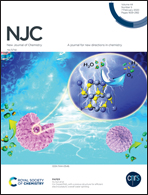Amino acid inspired tunable superparamagnetic iron oxide (SPION) nanostructures with high magnetic hyperthermia potential for biofunctional applications†
Abstract
Tunable nanostructured superparamagnetic iron oxide nanoparticles (SPIONs) with a saturation magnetization value of up to 79.4 emu g−1 were synthesized at room temperature with Fe(III) chloride and amino acid (AA) templates (alanine, glycine and glutamic acid), presenting a superior alternative to conventional SPION synthesis. Further, the SPION nanostructure building-block unit diversity and, correspondingly, its relationship with the magnetic as well as the biofunctional properties have been evaluated. The results demonstrate that the fundamental structures and crystallinities of the AAs play key roles in dictating the organization of the assembled structures and, therefore, the magnetization behavior. Fe–alanine, Fe–glycine and Fe–glutamic acid systems presented disc-like SPION nanocrystallite (20–30 nm), nanoheart-shaped (10–20 nm) and elongated flower-petal-shaped (30–40 nm) structures, respectively, which further assembled into helical nanostructures/microscale flowers at elevated AA concentrations. The SPIONs showed good cytocompatibility and DNA binding, and excellent magnetic hyperthermia potential even at lower concentrations (5 mg mL−1). The study presents a novel class of promising magnetic nanoprobes with tunable building-block units and microscale-assembled structures for magnetically targeted biofunctional applications.



 Please wait while we load your content...
Please wait while we load your content...